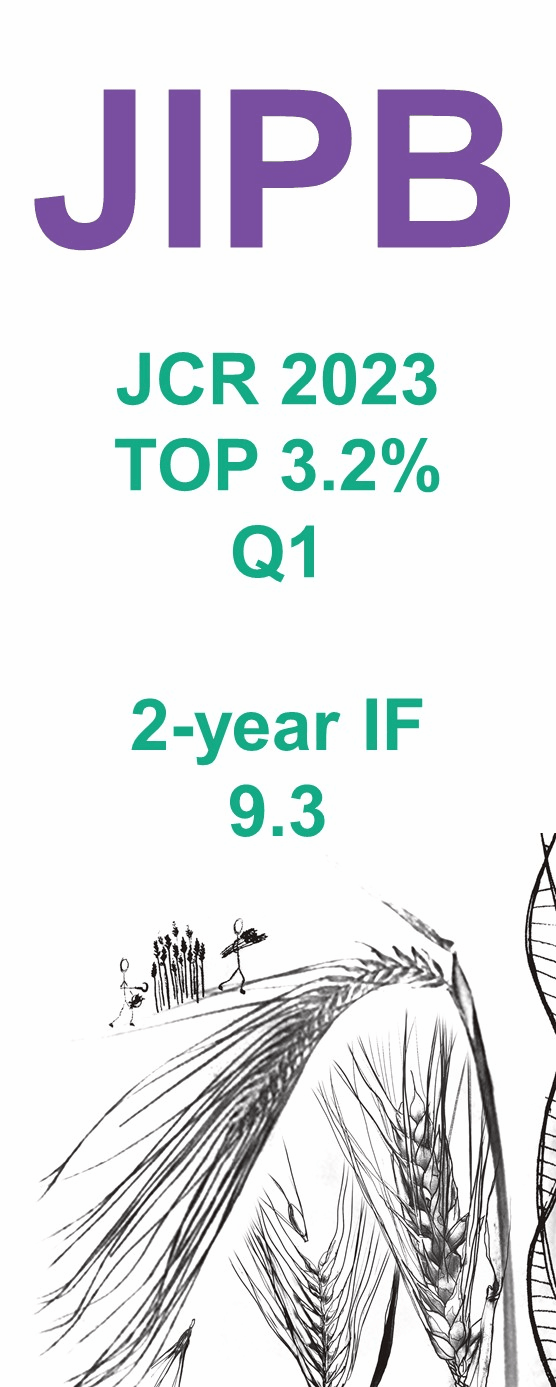-
Leibniz Institute of Plant Genetics and Crop Plant Research (IPK)
Corrensstr. 3, OT Gatersleben
D-06466 Stadt Seeland
Germany
Tel: +49-(0)39482-5341; Fax: +49-(0)39482-5595
E-mail: thor@ipk-gatersleben.de
http://www.ipk-gatersleben.de/en/independent-research-groups/plant-architecture/
Area of expertise: Cereal; wheat; barley; inflorescence; development; architecture; genetics; QTL; mutant; spikelet; floret

Selected Publications:
Poursarebani, N., Trautewig, C., Melzer, M., Nussbaumer, T., Lundqvist, U., Trutten., Tschmutzer., Brandt, R., Himmelbach, A., Altschmied, L., Rkoppolu, Hm., Youssef., Stein, N., Xin, Z., and Schnurbusch, T.H. (2020). COMPOSITUM 1 (COM1) contributes to the architectural simplification of barley inflorescence via cell wall-mediated and meristem identity signals. Nat. Communs. 11: 5138.
Abbai, R., Singh, V.K., Snowdon, R.J., Kumar, A., and Schnurbusch, T.H. (2020). Seeking crops with balanced parts for the ideal whole. Trends Plant Sci. 25: 1189–1193.
Sakuma, S., and Schnurbusch, T.H. (2020). Of floral fortune: Tinkering with the grain yield potential of cereal crops. New Phytol. 225: 1873–1882.
Wolde, G.M., and Schnurbusch T.H. (2019). Inferring vascular architecture of the wheat spikelet based on resource allocation in the branched headt (bht-A1) near-isogenic lines. Functional Plant Biol. 46: 1023–1035.
Wolde, G.M., Trautewig, C., Mascher, M., and Schnurbusch, T.H. (2019). Genetic insights into morphometric inflorescence traits of wheat. Theor. Appl. Genet. 132: 1661–1676.
Sakuma, S., Golan, G., Guo, Z., Togawa, Tagiri, A., Sugimoto, K., Bernhardt, N., Brassac, J., Mascher, M., Hensel, G., Ohnishi, S., Jinno, H., Yamashita, Y., Ayalon, I., Peleg, Z., and Schnurbusch, T.H.*, and Tkomatsuda, T.* (2019). Unleashing floret fertility in wheat through the mutation of a homeobox gene. Proc. Natl. Acad. Sci. USA 116: 5182–5187 (*joint corresponding-authorship).
Schnurbusch, T.H. (2019). EDITORIAL–wheat and barley biology: Towards new frontiers. J Integr. Plant Biol. 61: 198–203.
Koppolu, R., and Schnurbusch, T.H. (2019). Developmental pathways for shaping spike inflorescence architecture in barley and wheat. J Integr. Plant Biol. 61: 278–295.
Wolde, Gm., Mascher, M., and Schnurbusch, T.H. (2019). Genetic modification of spikelet arrangement in wheat increases grain number without significantly affecting grain weight. Mol. Genet. Genomics 294: 457–468.
Mckim, S.M., Rkoppolu., and Schnurbusch, T.H. (2018). Barley inflorescence architecture. In: Stein, N and G.J. Muehlbauer (EdS): The Barley Genome (Series: Compendium of Plant Genomes, VoL.XVIII), Berlin Heidelberg: Springer Nature, ISBN 978-3-319-92528-8 p. 171–208.
Guo Z, Zhao Y, Röder MS, Reif JC, Ganal MW, Chen D, and Schnurbusch TH (2018). Manipulation and prediction of spike morphology traits for the improvement of grain yield in wheat. Sci. Rep. 8: 14435.
Guo, Z., Chen, D., Röder, M.S., Ganal, M.W., and Schnurbusch, T.H. (2018). Genetic dissection of pre-anthesis sub-phase durations during the reproductive spike development of wheat. Plant J. 95: 909–918.
Guo, Z., Liu, G., Röder, M.S., Reif, J.C., Ganal, M.W., and Schnurbusch, T.H. (2018) Genome-wide association analyses of plant growth traits during the stem elongation phase in wheat. Plant Biotech. J. 16: 2024–2052.
Guo, Z., Chen, D., and Schnurbusch TH (2018) Plant and floret growth at distinct developmental stages during the stem elongation phase in wheat. Front Plant Sci. 9: 330.
Alqudah, A.M., Youssef, H.M., Graner, A., and Schnurbusch, T.H. (2018). Natural variation and genetic make-up of leaf blade area in spring barley. Theor. Appl. Genet. 131: 873–886.
Alqudah, A.M., and Schnurbusch, T.H. (2017). Heading date is not flowering time in spring barley. Front Plant Sci. 8: 896.
Youssef HM, Mascher M, Ayoub MA, Stein N, Kilian B, Schnurbusch and T.H. (2017). Natural diversity of inflorescence architecture traces cryptic domestication genes in barley (Hordeum vulgare L.). Genet. Resour. Crop Evol. 64: 843–853.
Guo, Z.F., Chen, D., Alqudah, A.M., Röder, M.S., Ganal, M.W., and Schnurbusch, T.H. (2017). Genome-wide association analyses of 54 traits identified multiple loci for the determination of floret fertility in wheat. New Phytol. 214: 257–270.
Youssef, H.M., Eggert, K., Rkoppolu., Alqudah, A.M., Poursarebani, N., Fazeli, A., Sakuma, S., Tagiri, A., Trutten., Govind, G., Ulundqvist., Graner, A., Tkomatsuda., Sreenivasulu, N., and Schnurbusch T.H. (2017). VRS2 regulates hormone-mediated inflorescence patterning in barley. Nat. Genet. 49: 157–161.
Alqudah, A.M., Koppolu, R., Wolde, G.M., Graner, A., and Schnurbusch, T.H. (2016) The genetic architecture of barley plant stature. Front Genet. 7: 117.
Guo, Z., Slafer, G.A., and Schnurbusch, T. H. (2016). Genotypic variation in spike fertility traits and ovary size as determinats of floret and grain survival rate in wheat. J Exp. Bot. 67: 4221–4230.
Guo, Z., and Schnurbusch, T. H. (2016). Costs and benefits of awns. J Exp. Bot. 67: 2533–2535.
Poursarebani, N., Seidensticker, T., Koppolu, R., Trautewig, C., Gawroński, P., Bini, F., Govind, G., Rutten, T., Sakuma, S., Tagiri, A., Wolde, G.M., Youssef, H.M., Battal, A., Ciannamea, S., Fusca, T., Nussbaumer, T., Pozzi, C., Börner, A., Lundqvist, U., Komatsuda, T., Salvi, S., Tuberosa, R., Uauy, C., Sreenivasulu, N., Rossini, L., and Schnurbusch, T. H. (2015). The genetic basis of composite spike form in barley and 'Miracle-Wheat' Genetics 201: 155–165.
Guo, Z., and Schnurbusch, T. (2015). Variation of floret fertility in hexaploid wheat revealed by tiller removal. J Exp. Bot. 66: 5945–5958.
Alqudah, A.M., and Schnurbusch, T. (2015). Barley leaf area and leaf growth rates are maximized during the pre-anthesis phase. Agronomy 5: 107–129.
Guo, Z., Chen, D., and Schnurbusch, T. (2015). Variance components, heritability and correlation analysis of anther and ovary size during the floral development of bread wheat. J Exp. Bot. 66: 3099–3111.
Alqudah, A.M., Sharma, R., Pasam, R.K., Graner, A., Kilian, B., and Schnurbusch, T.H. (2014). Genetic dissection of photoperiod response based on GWAS of pre-anthesis phase duration in spring barley. PLoS One 9: e113120.
Poursarebani, N., Nussbaumer, T., Simková, H., Safář, J., Witsenboer, H., van Oeveren, J., Doležel, J., Mayer, K.F., Stein, N., and Schnurbusch, T. H. (2014). Whole genome profiling (WGPTM) and shotgun sequencing delivers an anchored, gene-decorated, physical map assembly of bread wheat chromosome 6A. Plant J. 79: 334–347.
Youssef, H.M., Koppolu, R., Rutten, T., Korzun, V., Schweizer, P., and Schnurbusch, T. H. (2014). Genetic mapping of the labile (lab) gene: a recessive locus causing irregular spikelet fertility in labile-barley (Hordeum vulgare convar. labile). Theor. Appl. Genet. 127: 1123–1131.
Gawroński, P., Ariyadasa, R., Himmelbach, A., Poursarebani, N., Kilian, B., Stein, N., Steuernagel, B., Hensel, G., Kumlehn, J., Sehgal, S.K., Gill, B.S., Gould, P., Hall, A., and Schnurbusch, T. H. (2014). A distorted circadian clock causes early flowering and temperature-dependent variation in spike development in the Eps-3Am mutant of einkorn wheat. Genetics 196: 1253–1261.
Alqudah, A.M., and Schnurbusch, T. H. (2014). Awn primordium to tipping is the most decisive developmental phase for spikelet survival in barley. Funct. Plant Biol. 41: 424–436.
Koppolu, R., Anwar, N., Sakuma, S., Tagiri, A., Lundqvist, U., Pourkheirandish, M., Rutten, T., Seiler, C., Himmelbach, A., Ariyadasa, R., Youssef, H.M., Stein, N., Sreenivasulu, N., Komatsuda, T., and Schnurbusch, T. H. (2013). Six-rowed spike4 (Vrs4) controls spikelet determinacy and row-type in barley. Proc. Natl. Acad. Sci. USA 110: 13198–13203.
Bennett, D., Reynolds, M., Mullan, D., Izanloo, A., Kuchel, H., Langridge, P., and Schnurbusch, T.H. (2012). Detection of two major grain yield QTL in bread wheat (Triticum aestivum L.) under heat, drought and high yield potential environments. Theor. Appl. Genet. 125: 1473–1485.
Bennett, D., Izanloo, A., Reynolds, M., Kuchel, H., Langridge, P., and Schnurbusch, T. H. (2012). Genetic dissection of grain yield and physical grain quality in bread wheat (Triticum aestivum L.) under water-limited environments. Theor. Appl. Genet. 125: 255–271.
Sreenivasulu, N., and Schnurbusch, T.H. (2012). A genetic playground for enhancing grain number in cereals. Trends Plant Sci. 17: 91–101.
Gawronski, P., and Schnurbusch, T. H. (2012). High density-mapping of the earliness per se-3Am (Eps-3Am) locus in diploid einkorn wheat and its relation to the syntenic regions in rice and Brachypodium distachyon L. Mol. Breed 30: 1097–1108.
Youssef HM, Koppolu R, and Schnurbusch, T. (2012). Re-sequencing of vrs1 and int-c loci shows that labile barleys (Hordeum vulgare convar. labile) have a six-rowed genetic background. Genet. Resour. Crop Evol. 59: 1319–1328.
Izanloo, A., Condon, A.G., Langridge, P., Tester, M., and Schnurbusch, T. H. (2008). Different mechanisms of adaptation to cyclic water stress in two South Australian bread wheat cultivars. J Exp. Bot. 59: 3327–3346.
For Upcoming Special lssue:

 Scan with iPhone or iPad to view JIPB online
Scan with iPhone or iPad to view JIPB online

 Scan using WeChat with your smartphone to view JIPB online
Scan using WeChat with your smartphone to view JIPB online
 Taobao QR code
Taobao QR code
 Weidian QR code
Weidian QR code









